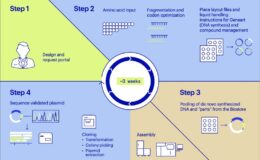Deoxyribonucleic acid, or DNA, holds the key to unlocking many mysteries.
Law enforcement began using DNA profiling in the 1980s to solve decades-old crimes. Today, tens of thousands of people have invested time and money into finding answers regarding their health, heredity and ancestry through commercial DNA testing companies. Now, the same science may prove critical to solving yet another mystery: what makes a veteran, at the rate of 20 a day, choose to take his or her own life? More importantly, does DNA offer a path toward predicting who’s likely to make that choice?
There’s no more helpless a feeling than trying to comfort the family of a service member or veteran who inexplicably took his own life or harmed herself in some way. At least that’s what it feels like to me and my colleagues at AMVETS who take the calls from veterans and family members in crisis or who need help immediately following a crisis. The most common refrain we hear is: “I wish I could’ve predicted it would happen or known the signs and acted sooner.” The bad news is that nothing can bring back those veterans who took their own lives. The good news is science, through the study of genomic material in DNA, may soon provide a way to predict and mitigate the risk of suicide.
A recent study conducted in partnership between the Department of Veterans Affairs, Yale and the University of California revealed that the consequences of military service, such as post-traumatic stress, can have an effect on genetic material. Specifically, scientists can now scan genomes and detect abnormalities caused by traumatic experiences — before a veteran reaches a breaking point — meaning doctors may soon be able to provide more customized treatment options with less trial and error. As a result, conventional medicine is a step closer to making “invisible injuries” more visible, and the shame, guilt and anger manifested through self-destructive behaviors better understood.
The remaining question is how long families will have to wait to realize the benefits of these breakthroughs. Right now, there’s a mom in New York who’s trying to coordinate access to care for her son, an Iraq War combat veteran with diagnosed post-traumatic stress, who’s nearly brain dead after a suicide attempt. There’s also a spouse in Idaho who cares for her husband, a former combat medic who is rated 100 percent disabled through the VA for his psychological and traumatic brain injuries, who wonders when the next PTSD-fueled crisis will hit them like a ticking time bomb. Older veterans, combat veterans, recently separated service members and women veterans face suicide at a rate statistically higher than their non-veteran peer groups. To say that time is of the essence states the painfully obvious, and collective efforts must reflect this urgency.
To the VA’s credit, the Million Veteran Program initiative has made some strides. Through this initiative, VA medical centers have collected genetic material from veterans on a voluntary basis for the purpose of studying the relationship between genetics and the traumatic experiences inherent to military service. However, like most scientific research, progress has moved at a glacial pace since the initiative launched in 2011. By all indications, the VA has what it needs to better understand the physiological effects that surviving a military sexual trauma or a bomb blast in combat has on the brain, as well as how biomarkers can determine the most effective treatment in a particular case. When we will see the benefits of this progress in clinical practice at VA medical centers, however, remains to be seen.
Dr. Tshaka Cunningham, a Princeton University, Rockefeller University and NIH-trained molecular biologist and former scientific program manager for the VA’s Aging and Neurodegenerative Diseases Rehabilitation Research Program, said, “We have already shown how understanding an individual’s genomic profile can provide insights on predisposition to PTSD from studies of victims of the 9/11 World Trade Center attacks as well as Holocaust survivors. We have a patented set of such genomic biomarkers that can be used to make better diagnostic tests for PTSD. The VA’s samples that were obtained through the Million Veterans Program offer a new frontier of discovery that has yet to be fully explored. We must do all we can to take advantage of this opportunity, for the sake of our nation’s heroes who live with the greatest risks.”
AMVETS agrees and has taken a lead role in urging our government and the scientific community to make better understanding and improving care for women veterans a top priority.
Yusuf Henriques, former Army combat medic and co-founder of TruGenomix, a service-disabled veteran-owned precision genomics company looking to reduce the high rates of suicide among veterans, recently answered AMVETS’ appeal with his prescription for progress. “The key is to take all of the 50,000 to 60,000 female veteran DNA and RNA samples the VA has available and do a thorough longitudinal study on the genetics of female Veteran PTSD and suicide,” he recommended. “These samples can remain anonymous with relevant clinical data attached to ensure privacy while offering a treasure trove of new information that could save lives. However, access to the Million Veteran Program samples remains challenging.”
It’s time to turn potential into practice. At a time when social media campaigns and legislative fixes have fallen short of inspiring widespread confidence in efforts to curb veteran suicide, there is a reason to be highly encouraged by the endless possibilities that genomics offer. However, it will require continued investment, expanded partnerships, and the distribution of accountability at all levels, across all relevant sectors. How we can get there — and pull families out from the trapped sense of helplessness they often face — is no longer the question before us. The question is whether we’re indeed ready to do everything possible, as soon as possible, to stop 20 veteran suicides a day.
Sherman Gillums is a retired U.S. Marine officer and AMVETS chief advocacy officer.


















